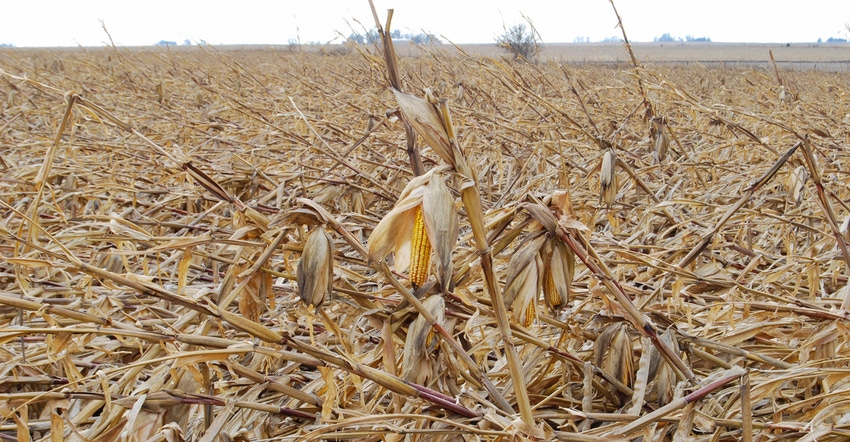October 30, 2020

As harvest 2020 wraps up in Iowa, many farmers are focused on crop marketing and storage decisions, and developing a plan to meet cash flow needs. Crop insurance and federal aid programs will help offset yields hurt by the drought and derecho. Also, crop prices have recently improved. But crop insurance and government aid won’t make up for all the financial losses farmers have incurred.
“You need to do a good job projecting your cash flow needs,” says Steve Johnson, Iowa State University Extension farm management specialist. “Developing a sound crop marketing plan will help, too.”
Related: Surviving a challenging year
Taking advantage of higher corn and soybean prices, and forward-contracting some 2021 crop production are moves some farmers are making. Central Iowa farmer Rod Pierce is one them.
“I’ve got a good [actual production history] yield, so that helps me feel comfortable about selling ahead. And I’m going to get a good crop insurance payment for 2020’s losses due to the derecho and drought,” he says. “Collecting on crop insurance isn’t my goal. I’d rather produce a high-yielding crop, but crop insurance will help provide cash to meet my needs for planning the 2021 crop.”
Many different options for crop insurance are available. “I’m glad I had the 85% Revenue Protection coverage for 2020 with a 10% add-on RP policy,” Pierce says. “All of us farmers need to understand the different options and make sure we choose the one we really need to best fit our farming situation. Make sure you have a knowledgeable crop insurance agent to advise you. Crop insurance can get complicated with various coverage options. And sometimes there are price discounts offered on the add-on policy above the base RP.”
Keeping up with USDA farm programs and deadlines is also critical to farming, Pierce says. Check with your local Farm Service Agency if you have questions.
Program payments
In October, Iowa farmers received payments from several programs administered by FSA. These include the Conservation Reserve Program, the 2019 Agricultural Risk Coverage and Price Loss Coverage programs, and the new Coronavirus Food Assistance Program 2
(CFAP 2) payments. ISU’s Johnson provides the following update.
A typical 2019 PLC payment for corn is $16 per base acre, depending on the old PLC yield on that farm. Agriculture Risk Coverage County (ARC-CO) payments in Iowa averaged $1.60 per corn base acre and were projected to be made in only 11 counties statewide.
A typical 2019 ARC-CO payment for soybeans in Iowa was roughly $5 per base acre. Only 36 counties were expected to trigger payments. There are no PLC payments on soybean base acres enrolled.
About 80% of eligible corn base acres nationwide were enrolled in the PLC program for both the 2019 and 2020 crop years. This same percentage, about 80% of the eligible soybean base acres, were enrolled in the ARC-CO program. The final enrollment percentages for Iowa have not yet been released by FSA and will include a few thousand farms that enrolled in the ARC Individual (ARC-IC) program by farm and by crop for this two-year period.
Decision tools for figuring ARC and PLC payments are available on the Iowa State University Ag Decision Maker website. The site also has links to recordings of ISU Extension webinars explaining government farm programs and financial assistance, such as the recent presentation, “2020 Government Payments and Active USDA Programs.”
Deadlines to know
Here are key deadlines for 2020:
CFAP 2. The new Coronavirus Food Assistance Program 2 payments are now being made. If you haven’t yet applied, you have until Dec. 11 to do so. For commodity crops, these payments will vary based on APH yields on a farm.
Payments are expected to be roughly $35 per planted acre for corn and $15 per planted acre for soybeans. Additional commodities are also eligible for CFAP 2 payments that might not have been eligible for CFAP 1. A complete list of eligible commodities, payment rates and calculations are at farmers.gov/cfap.
Producers seeking one-on-one support for the CFAP 2 application process can call 877-508-8364 to speak directly with a USDA employee. This is a recommended first step before a producer engages with the team at a local FSA county office.
WHIP-Plus program eligibility. Other potential payments exist for both the 2018 and 2019 crops under the Wildfire and Hurricane Indemnity Program — Plus. The application deadline was Oct. 30. WHIP-Plus is an all-encompassing disaster aid program for hurricanes, floods, snowstorms, tornadoes, typhoons, volcanic activity, drought, excessive moisture and wildfires occurring in 2018 and 2019.
Drought and excessive moisture were added as eligible losses for the program in March, which made more Iowa crop acres eligible. Many crop insurance agents were made aware of this program since it involved county disaster declarations.
Keep in mind that for the WHIP-Plus program, drought-loss eligibility is for 2018 and 2019, not 2020, according to USDA. A new tool is at farmers.gov/recover/whip-plus.
Crop insurance payment. As a result of the severe summer weather events this year, the USDA Risk Management Agency authorized approved insurance providers to offer policyholders extra time to pay premium and administrative fees.
Plan to pay your 2020 crop insurance premium on or before Nov. 30 to avoid a penalty and the accrual of interest charges. Farmers with crop insurance questions or needs should contact their insurance agents. Information is also at rma.usda.gov.
About the Author(s)
You May Also Like






